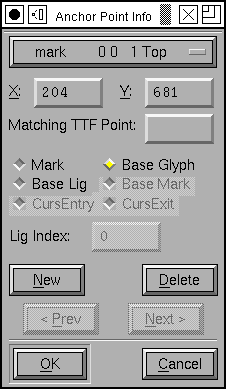

This menu is only available in the Outline Character View.
 This command
adds a new anchor point to the glyph.
The last click in the window provides a default location for the point.
This command
adds a new anchor point to the glyph.
The last click in the window provides a default location for the point.
See the overview and the Element->Get Info command for more info.
FontForge chooses an ellipse which runs through the two points and is tangent to the slope at those points. This is not enough information to determine an ellipse (three points and two tangents are needed) so in general there will be an infinite number of solutions, thus FontForge may not pick the one you had your heart set on.
It is also possible to specify a set of input constraints which cannot be met by any ellipse.
FontForge will first search for ellipses so that one of the selected points lies one of the axes of the ellipse. If it can't find one like that it will perform a more general search.
(If you hold down the <Alt> key when you select the menu item, then FontForge will place a copy of the full ellipse into the background layer -- this was for debugging, but I thought it kind of cool so I left it in).